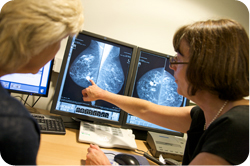Breast Unit
Fine Needle Aspiration (FNA)
Fine Needle Aspiration (FNA)

|
On this page: What is it? Are there any risks? Who will do the test? Preparing yourself for the test What does it entail? How long does it take? Will it hurt? When will the results be available? |
What is a fine needle aspiration of the breast?
Not everyone attending a breast clinic has a fine needle aspiration of the breast.
It is a way of taking off fluid or a few cells, so that they can be examined under a microscope. It is not actually a biopsy, as intact tissue is not removed, although some people may call it a biopsy.
The abbreviation is FNA.
Are there any risks in having an FNA?
It should be stressed that the answer is generally no. Occasionally, there may be some bleeding inside the breast and a bruise or swelling (haematoma) will form.
Obviously care has to be taken that no infection occurs. Care must also be taken that the needle does not pass beyond the breast through the chest wall (special care would be taken if a lump is at the back of a small breast).
Needle procedures of this kind require the patient's verbal consent.
Who will you see when you have an FNA?
The Breast Specialist Doctor will perform the fine needle aspiration, if required.
Are you required to make any special preparations for an FNA?
No, but you might like to wash your breasts before coming to the clinic.
If you are taking tablets to thin the blood (anticoagulants) you should tell the doctor or radiographer.
What does an FNA entail?
Generally, a small needle, similar to the one used for taking a blood sample, is placed into the breast and into the area being studied. A local anaesthetic may be used.
Using a syringe on the end of the needle, suction is applied to draw up fluid and cells. The needle is moved up and down through the breast tissue while this is happening. The needle is then removed, and the material placed in a special bottle or on to a microscope slide.
The procedure may then be repeated once or twice more.
If the abnormal area can only be seen on ultrasound, the radiologist needs to use the ultrasound sensor at the same time to make sure that the correct area is sampled.
How long does an FNA take?
Again, this depends on how it is being done. If the doctor can feel the abnormal area, it only takes a few moments. It will not take much longer with ultrasound guidance.
Will an FNA hurt?
If you have one, you might feel some stinging or a stabbing pain while it is being done, but this does not last. Often local anaesthetic is used.
If there is bruising and a hard swelling (haematoma) forms afterwards, this may be uncomfortable for a day or two. Most women do not find an FNA too painful, and tolerate it very well.
When will the results be available?
Once the ultrasound FNA has been performed, the sample will go to the pathology department for processing. This will take a few days and the results will be available within 5 working days.
You will be given an appointment to return to the breast clinic to discuss your results with a specialist within 7 days of the test being done.


